I’d done it once again.
The fact that I’d pulled it off is one thing, but under such a time crunch?! In a rush to meet a friend? That takes poise.
Standing there as the warm water beat the back of my head, I glanced down at the bar of soap clutched in my hand and smirked. This is what Denzel must’ve felt in Training Day. King Kong? Psshhh.

Minutes prior, I had been scrubbing myself in the shower, perhaps with a bit too much zeal. I was running on a high from the day’s events— the bike tour, my new French friends, Pompidou, and enthusiasm was rising for Sally’s visit. And so, I was attempting a record-setting shower pace. But as I tried to suds up my left pec, the bar slipped through my hands and was launched into the air, skipping upwards off the white-tiled wall, then free-falling to the shower floor at a blistering 9.81 meters per second.
If you are not an experienced bar-soap-showerer— a ‘Lye-Guy’[1]— then you probably think I’d be screwed in a situation like that. He’ll never catch that slick, fleeting soap. Having been so (understandably) sucked in by the luffa + body wash trend of the late-nineties and early aughts, a falling bar of soap causes you to panic. You’re desperate clasps resulting in that most feared moment for the Lye Guys (and maximum security prisoners): a floored soap bar.
Hey, I get it. I was once a Luffite. I too succumbed to the lathered-paradise that was the luffa doused with Old Spice Pure Sport. I just feel cleaner, I’d claim, exfoliating with a righteous smile.
But no longer, my dear reader. These days, I’m a Lye Guy— and a snobby one at that. And we ain’t talkin’ Dove. Mainstream bars are no longer good enough. Now, I need higher end brands, their packaging complete with bulleted lists of paraben-free promises. What’s a paraben? Who cares. The point is, a plummeting bar stirs not panic, but opportunity. So in that tiny Parisian shower, gravity was no match. With a monks calm, I extended my hand (the left no less!) underneath the descending bar in optimal catching position.

And now comes the really impressive part. Because the real challenge isn’t positioning the hand in catching position. Of course— it’s securing the dropping bar. The soapy bar and wet hand don’t offer a whole lotta friction. And as any rainy-game wide-receiver knows, a snatch won’t do the job. The bar must be cradled, as tossed raw egg with a spoon. To paraphrase Seinfeld, it’s not taking it that is most important, it’s holding onto it. And so, with a mind like water, I held my hand softly, gave as the bar hit my palm, rocked it pendulum-like, and absorbed the fall—a perfect Soap Catch.

Obviously, I was more than deserving of a celebration here, but I took the high road. Regarding this as a mere expectation (rather than the monumental event it’d have likely been for you), I lightly placed the bar in the dish, barely raising the corners of my mouth. I’d been there before— a seasoned vet— so instead of spiking the ball into the ground, I calmly hand it to the ref, and trot back to the sidelines. The Jerry Rice of Soap Catches.
And so now you’re thinking, I don’t know what’s more impressive here— the poise of the catch or the professionalism of the aftermath. Believe me, I had trouble deciding myself. And I would have thought about it for a lot longer, but, unfortunately, I couldn’t just stand there admiring myself all night, I had to go meet Sally.
So, with a brief acknowledgement of my godly feat, I rinsed my body, and stepped out of the shower. I was meant to be at Sally’s hotel in less than 10 minutes.
When Justy Met Sally
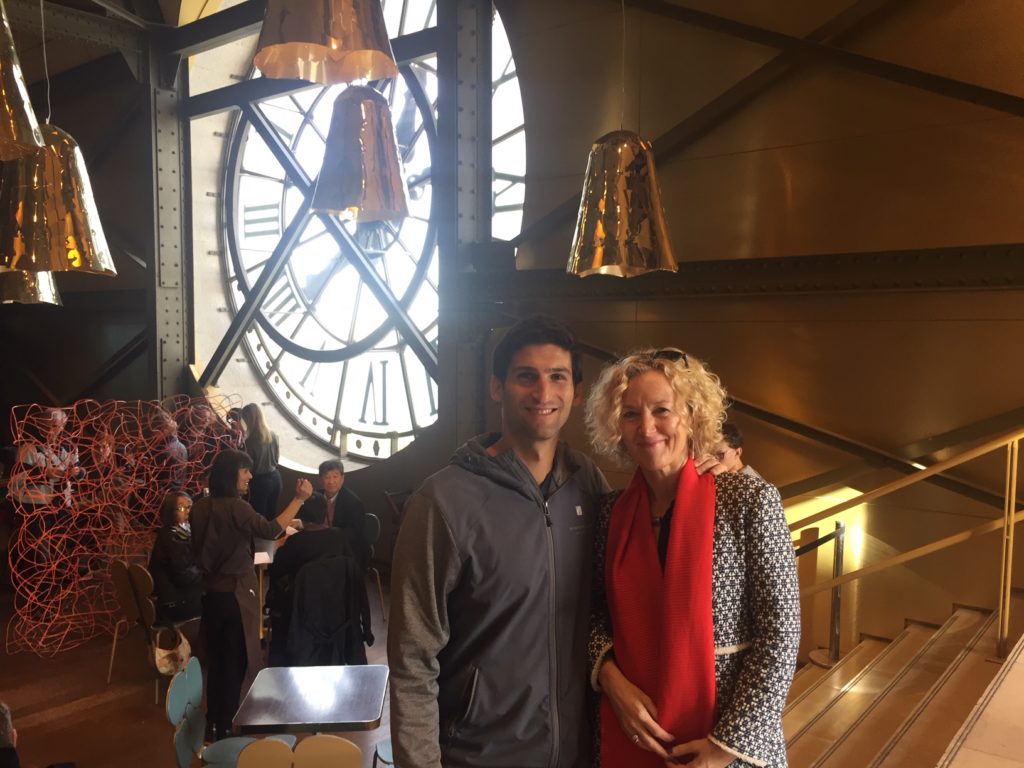
I WONT BLAME YOU if you find my relationship with Sally exceptionally strange.
Just the fact that she’s about 20 years my senior might alone give you pause. I can hear my 100 year-old, Manhattan-accented grandmother now: what’s wrong with him? can’t he find a girl his own age?! And if the age thing doesn’t make you squirm, how about that she’s from northern England and that we met by random chance at a Seth Godin workshop in New York three years ago, and that we’ve sustained our relationship via regular FaceTime calls and international meet-ups. Repulsed yet? Well, I won’t hold it against you. I totally get it. For you, (and everyone else), this is weird.
Of course, for me, it’s completely normal.
For as long as I can remember, I was always interested in people older than me. I swooned over older girls and I wanted to befriend the older guys. Ever since first grade, whenever I’m on planes, I invariably strike up a conversation with some senior citizen. At parties in high school, I was the type of person who’d spend the majority of the evening speaking to the nearest 50-year-old chaperone.
In fact, last weekend, at an afternoon party in Manhattan Beach, I spent approximately 30% of the time with Natalie (her friends call her ‘Li Li,’ but her daughter, and now I, are the only ones who call her ‘Nat’), who is probably about 58 years old. When Nat left the party for a red-eye flight bound for Baltimore, she told me I was her favorite. As she got in the cab, my friend Katie turned to me, rolling her eyes: ‘Jesus, Justin, the one adult here?! Really?!’
So my relationship with Sally, a woman of probably ~50ish (please let that not be over) isn’t me-strange; it’s just society-strange. And whenever I am about to meet her in some European or American tryst, I often think about that first evening we met.
*
THE FIRST TIME I MET SALLY, I was sitting at the apex of a half-mooned booth in the back of a darkly-lit Manhattan bar, surrounded by three strangers. We’d all come from a full day of lecturing at the Fashion Institute of Technology lead by the great, Seth Godin. Having volunteered for an after-dinner where you’d be randomly assigned 3-4 other dinner guests, we were sipping cocktails in this Chelsea restaurant, all of us wondering if the 5th and final person would ever show.
Right after receiving our drinks (mine: Old-fashion, hold the Domino’s sugar cube, add a Brandi-soaked cherry), the group’s attention was drawn by our finally-arrived dinnermate. I was busy trying to spear the sinking cherry out of my drink when I heard a British accent coming from my left. And it wasn’t that approaching-arrogant, Queen Elizabeth accent you might be imagining. The voice was soft and alive; coated in honey and infused with electricity. I briefly gave up the fishing expedition, looked up, and then I saw her face… and then I was a believer.
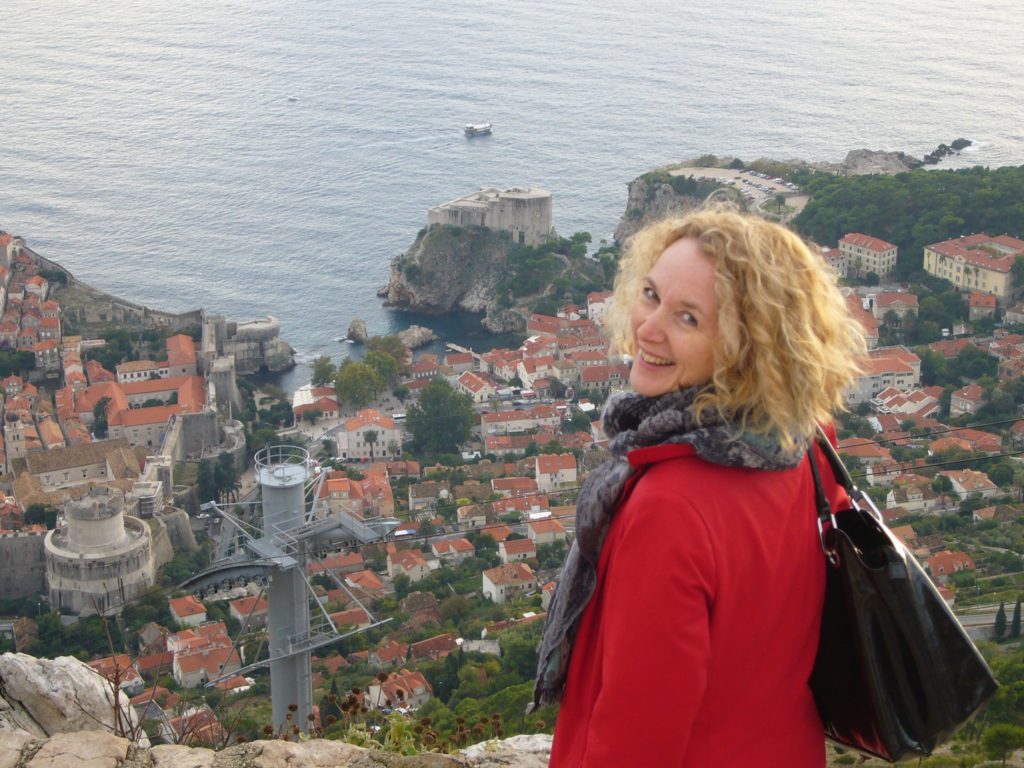
It was aglow. Not just her face, or her smile, which were both bright enough to set that dimly lit booth ablaze, but her entire ora. Maybe it was her pale yellow hair, cut just below her lobes, bouncing and waving, like those dancers dangling on tall, silk sheets. Or maybe it was the red, wool coat, which served as the staunch, monochromatic, Ms. Independent compliment to her, vulnerable, rudy cheeks. But then, I doubt it was any of these things— they’re much too far from core.
It must have been—and I thought this right on the spot— her soul. I’m no Rabbi (though I have played one at a wedding), but there’s something that is the spirit of a person, isn’t there?[2]. You can gain or lose energy upon contact, even if you don’t know them that well, or at all. When I looked at Sally, I didn’t just sense the rising in my own mood, but a buoying of the collective. What had, moments before, been a middling, bumbling spatter of what-do-you-dos and where-are-you-froms, was now thrust into intrigue. We went from facts into feelings; from contrived to confiding. And we never looked back.

After the meal, Sally and I shared a hug that was more than what you’d get from a stranger, even for a Hugger like myself. The dinner had been about 3 hours, sure, but I didn’t hug the others in this way. And when we told each other we’d stay in touch— that we’d FaceTime or What’sApp (her living in England)— we knew that we actually would.
And we did. We stayed in touch, having regular video chats, often on Sundays for the following two years. One time, I met her in New York and we attended a version of McKee’s famous Story Seminar. And now, I was on her continent, so of course, I rung her on the tele (or does that mean TV?).
*
I ARRIVED IN THE LOBBY OF SALLY’S hotel around 8:30pm, slightly tired and trying to rally. We were going to head to dinner, though we were yet to decide on the destination. On the walk from Le Marais, over Rue des Francs Bourgeois, I remember the distinct feeling of ownership, autonomy. I was welcoming a guest. It was like I’d lived in that area for years. The singular image that came to my mind, was that of walking down Viale de Trastevere in Rome, over a decade earlier on the way to see my visiting mom and sister. I spoke some Italian, I passed by the familiar Palazzos, I ordered a steak, ‘ben coto.’
The difference is that in Rome, by that point, I’d already had not only thrice-weekly classes in Italian, but also the benefit of being immersed in the language and land for nearly two months. Here, in contrast, I’d been in Paris for a few days, so when I sampled out my French with the quite pleasant concierge, I stumbled, only slightly less than I had ordering that first croissant. Luckily, minutes later, Sally emerged from the elevator, bright and bold as ever, igniting the room, her hug, waking my tired head.
On the recommendation of the concierge, we walked just a few blocks away to a local seafood restaurant where we split some fish and veggies and got caught up. We smiled and laughed and gushed enthusiasm as we planned out our next couple days over the last of our champagne and chocolate tart (a la mode, of course).
We were already scheduled to head to the Orsay museum on Tuesday, but needed some ideas for the next day. Several ideas came up for an activity. The place we settled on is also a sort of museum— a museum of the dead. Or as Ace Ventura might call it, ‘a lovely room of death.’
In Search of The Dead: Cimetière du Père-Lachaise
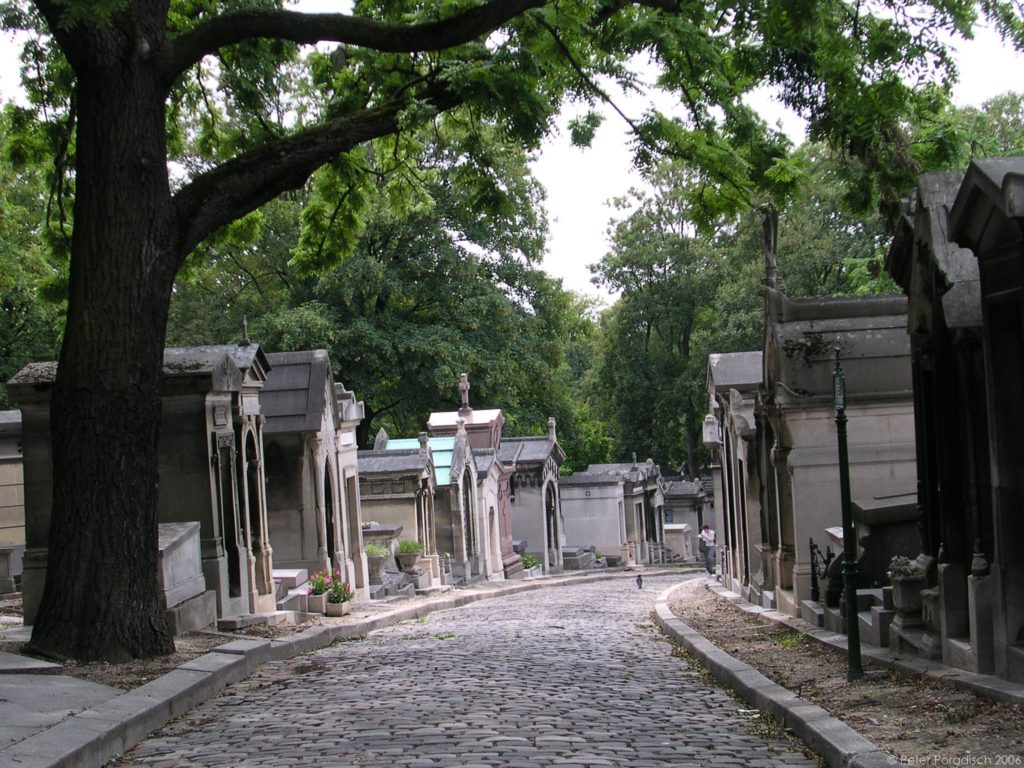
I woke the following morning early to gray and chilly sky. Given the over-indulgence in the Parisian cuisine, I was itching for some exercise. The brisk autumn weather was perfect for some calisthenics, and I had just enough time on my hands until I was to meet Sally for breakfast.
I started off jogging southwest out of my flat towards the Seine, earbudless and attentive, the only sounds, my breath and the pattering of old sneakers on concrete. Rather than music or a podcast, I preferred to listen to the just-before-sunrise soundlessness of the waking city.
During the work-week, you can almost never achieve this in New York City, no matter how early you start (it doesn’t sleep much). But in Paris, as people were just getting out of bed, maybe cutting some fresh baguette, I crossed the Pont Notre Dame to the Left Bank, half way to the Pont Neuf. I’d spotted a little grassy area the day before.
When I arrived on the grassy knoll, warm and ready, I quickly went through a makeshift routine– push-ups, squats, etc. I didn’t have a whole lot of time before I was due to meet Sally for breakfast. And as I finished out my burpees and lunges, I also paid attention to the nothingness. It seemed the sounds from my body hitting the hard, cold ground, and my grunts and gasps were the only ones in all of Paris. This made me feel strong, like Rocky or something. In He Got Game, as Denzel runs Jesus through drills before dawn, he tells his son something like: “Only you and Michael Jordan are up working right now. Everyone else’s asleep.” I added myself to that list temporarily. (So, to recap, that’s me, MJ, Denzel, and Ray Allen. Equal.).

I headed back to my place to shower quickly before meeting Sally at what would become a favorite coffee shop: Strada Café. We met, ate, drank some quality coffee (a surprising rarity in Paris), and headed out to go pay our respects.
*
THE PERE LACHAISE CEMETERY is located in the 20th arrondissement— approximately three kilometers north-east of Le Marais (35 min walk). Sally, as always, was supportive of a weird, exploratory idea. She was also aware of its famous membership and had particular interest in visiting a few of the buried writers and musicians. We decided to walk the thirty-ish minutes, through Saint Ambroise, and enter through the western gate.
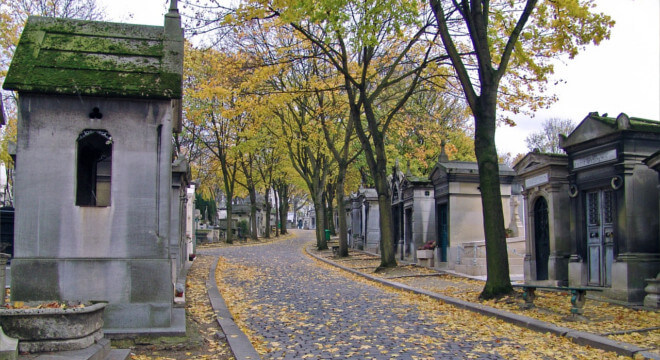
That particular Monday was perfect for the dead. The overcast, breezy day was just the eerie weather you’d write into any cemetery scene. And it was just the type of background to amplify my long-held irrational fear of gravesites.
I felt chills run up my back as we entered the Adam’s Family-like gate.

CEMETERIES FREAK ME OUT. It’s some kind of odd combination of disgust, sadness and fear. I am particularly repulsed by the classification of big cemeteries like this one as a ‘necropolis.’ Further, I find the whole idea of interment one of the very oddest of human proclivities. I say proclivity, not ‘custom,’ because ritualized burial seems to be more than a mere tradition— something that is done because, hey, we’ve always done it this way. Apparently, humans have been doing it for tens of thousands of years, through hundreds of cultures and trends, dating back to the Neanderthals. So perhaps it’s not just something we happened to do, but something we must. Something innate.
The only reason, it would seem, to place someone in a comfortable (expensive) bed in the ground, is our persistent belief, or desire to believe, that we are something more than material bodies. We want the dead to ‘rest in peace’ and we often come back to visit these places and talk to their tomb.
The Egyptians took this to the enth degree. They pulled out people’s brains through their noses with hooks, filled the lifeless bodies with preserving liquid, and then buried them (if they were regal), with the equivalent of millions of dollars. They covered it all with hundreds-feet-high prisms made of thousand-ton stones carried over desert and river by a sea of slaves. These elaborate grave-houses are one of the Seven Wonders of the world. Yes, a wonder, indeed.
I’ve never been totally convinced of the necessity or value in this process. And yet, cemeteries affect me. If I am walking at night and pass by a cemetery, my anxiety levels will noticeably rise. Typically, I can withstand about thirty seconds of this walking until I set off on a dead sprint to safety.
And it’s not limited to this Halloween-inspired fear. I also cry when Forrest is telling Jenny’s tomb how smart little Forrest is. I get emotional when Doctor Cox visits Ben. And, if you can believe it, even in real life.
You might say it’s not the place itself— that it’s just the memory of the deceased— and you may be right. But I think there’s more to it.
*
THE CEMETERY IS SET UP like a maze with a map—and a quite unhelpful map at that. It consists of a bunch of confusingly numbered gravesites which correspond to a single guide displayed on a glass case when you first enter. The key is about as helpful as a how-to book on solving the Rubik’s cube. Even if you snap a picture of map when you walk in, it’s pretty hard to distinguish one meandering path from another, which renders the entire numbering system useless. We’d decided that we wouldn’t use our phones unless we really needed to, so we mostly relied on our collective sense of direction and, of course, the ghostly urge of the whispering spirits.
Those whispering spirits were initially collected in this necropolis (yuck) when basically everything else was— under the rule of Napoleon. Named after the ‘Confessor’ on site, the yard was commissioned to accept the deceased just three days after the Napoleon was coronated in 1804, making it one of the very first things the great man would give to the city. Of this gift, he reportedly said: “Every citizen has the right to be buried regardless of race or religion.” Let freedom ring. I guess if you’re going to be discriminated against your entire life, this is a comforting consolation.
For some reason I can’t shake the image of the 5-foot-and-change general, bedecked in stockings, platform tap shoes and a triangular, Haman-like hat. The groggers probably rang into the distance as he reached up to a bright red ribbon with a pair of clown sheers 1/3 his size and congratulated himself as he bestowed upon his people the civil right to be plunged into a hole in the ground.
*
WE STARTED OUT NORTHWARD, headed for the graves of Proust and Balzac, as we remarked on the strange beauty of the graveyard. The tombs lining either side of the swerving dirt path came in all sizes and shapes, from various eras, built of myriad material. Some were just your basic tablets shoved into the dirt, on them the standard inscription: ‘here lies’ so and so. Others were baroque— almost offensively so. They were built like mini-castles, towering over the more pedestrian standard-shaped, stone-slabs. I guess you can take some of it to the grave.
We walked slowly, but intently, keeping in mind the site of principal interest— that of a late-19th century Irish poet who, though he’d gained fame in London his 20s, ultimately died, poverty-stricken and shamed by the sort of ignorant injustice of which only us humans are capable.
For what exactly was the once-revered poet shamed and exiled? For being himself— a gay Irish man in an intolerant Victorian age. What the court called ‘gross indecency.’ Following his imprisonment, his funds having gone to pay the legal fees of his persecutor, he fled to France where he’d live out his last days hardened, weakened, and drunk. He died of meningitis in 1900 due to an injury sustained while in prison.
After about 20 minutes of looking for the writer’s grave, we nearly gave up. But, at the last second, Sally had a premonition. We followed it and after a little more zig-zagging through withering blocks of stone and wood, we finally reached the site. And though we’d never been there before, we knew that this was what we were looking for. It was like nothing we’d ever seen.
In front of us, a huge stone soared into the air covered in lipsticked kisses— hundreds of them, maybe thousands. Though its lower half had since been quarantined by ‘protective’ glass, the decades of glossed lips continued onto the barrier itself. The kisses had been deployed by strangers from all over the world—people he’d touched deeply, yet never knew. He must have reached them in that way only a writer can: by writing something true; some universal reality that transcends time and skin.
On the back of the stone was a verse from a poem—one he had written while in exile. I read it aloud as my face warmed and eyes welled:
And alien tears will fall for him,
Pity’s long-broken urn,
For his mourners will be outcast men,
And outcasts always mourn.
The Ballad of Reading Gaol
Chills returned to my back as I reread it once more to myself and tears filled my eye lids. Even 100 years of loving strangers and artistic fame are not worth the cruelty that befell Oscar Wilde.
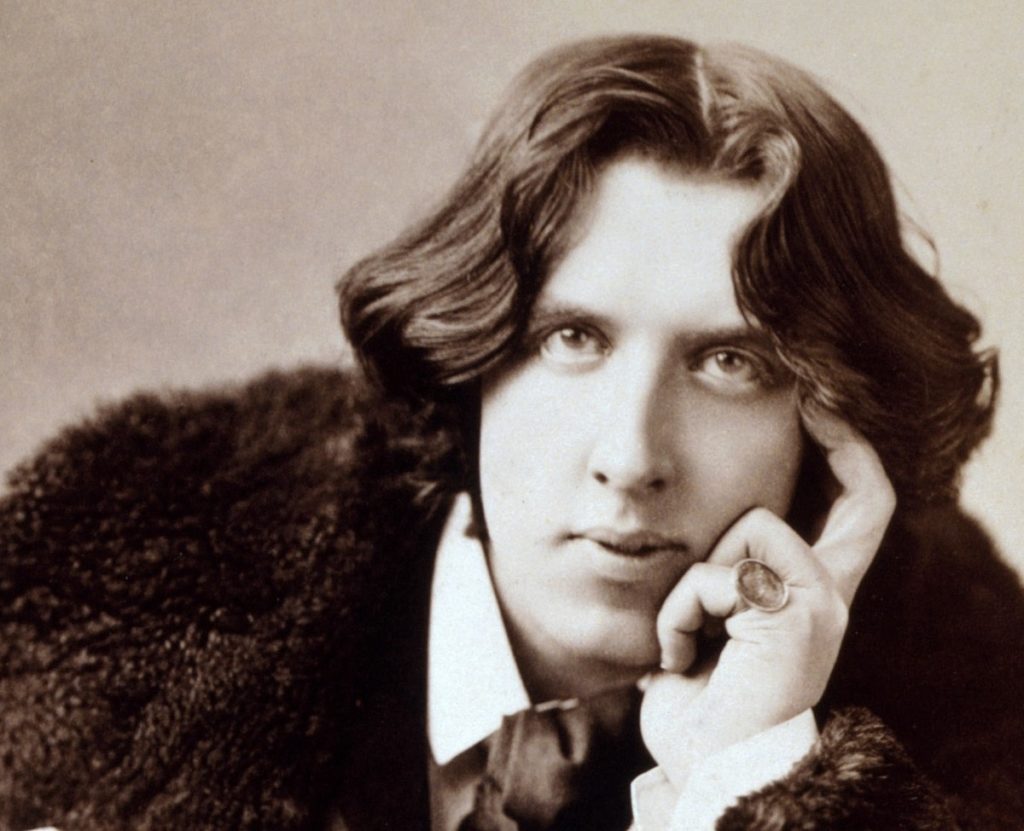
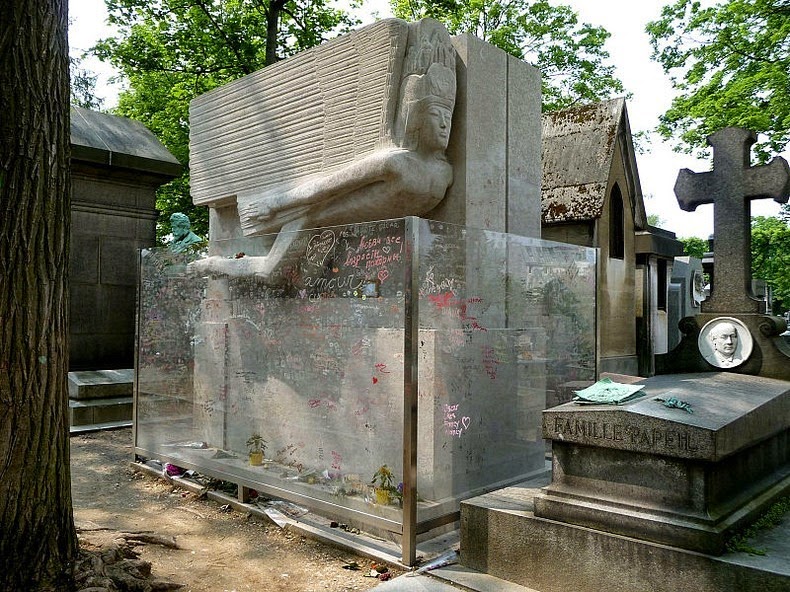
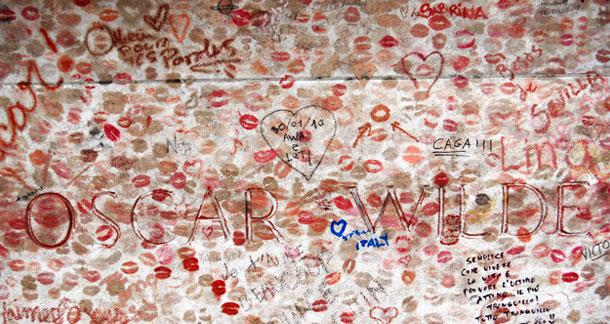
FOLLOWING OUR WILDE EXPERIENCE, emotional and present, we wandered Eastward, in a sort of reflective silence. We had one more grave to visit. It was another Good who’d died young, but much younger than Wilde. His death, probably self-inflicted, came at the infamous age of 27, joining the eponymous club of famous rockers. As we headed off, down another stone-lined path, I wondered why an American rockstar like Jim Morrison would be buried in Paris. Then LA Woman started playing in my head, and though I continued to stroll, my mind went off to another time.

Years before, living in New York City, I often drove with my roommate, Brian. Sometimes, if we really wanted to get fired up, he’d take out his Doors Greatest Hits CD (he was, to his delight, I think, the last person under the age of 50 using CDs in 2013) and put on LA Woman. He’d start the song, the symbols and that intro lead, at about a five-out-of-ten decibel: Well I just got in town bout an hour ago. And then as the verses and chorus moved along— City of Night, City of Night— he’d moved the dial to a seven-out-of-ten. And eventually, we’d get to the bridge— Mr Mojo Risin’— and as it climbed to climax, he’d jack it up to a ten-out-of-ten. MOJO RISIN,’ RISIN’ RISIN.’ Windows down, the sun-roof back, and that dirt-white, 100,000-miled Highlander hand-me-down would be screaming down the Westside Highway, Jersey-bound. We were, of course, on our way to play country-club golf. Very psychedelic rock.
Quick side note— and I am not making this up. As I type this on July 19th in Venice at 9:03 AM, playing on the radio, I just noticed to my horror, is the Doors’s, Riders on the Storm! I assume this is Jim urging me to continue telling his story. I shall, my dear Jim. I shall.
So why Morrison in Paris?
It turns out, days before his death, he’d taken a trip out to Paris and stayed in Le Marais with a woman named Pam Courson. And then, less than a year following the two-week-apart overdoses of Jimi Hendrix (London) and Janis Joplin (Los Angeles), Pam found Morrison, dead in her bathtub. The cause of death was unknown. But I think many suspect something similar— the absurdity of life.
A poem was found in his possession. “I have drunk the drug of forgetfulness,” It read.
It ended: “last words, last words out.”
***
AFTER WANDER FOR AT LEAST ANOTHER 30 MINUTES, we eventually happened on the the decorated grave site. In front of us was a woman, blonde, wearing leather pants and jacket, probably in her 60s, crying on a man’s shoulder. It looked personal, as if she’d known the Morrison. Phrases covered the grave in pen and marker— things like “Jim Forever”— and flowers surrounded the tall stone.
I stared at it for a while, and then back at the crying woman, and then at Sally. I always liked the Doors music, but I never was so Doorsian to justify any kind of drastic emotion at that moment. And yet, a deep sadness came over me, whether for Morrison or for the crying woman. Or perhaps it was just for a sense of unjustness, a sympathy for the young and dead. For those who followed Mick Jagger’s unsettling preference to die before getting old.
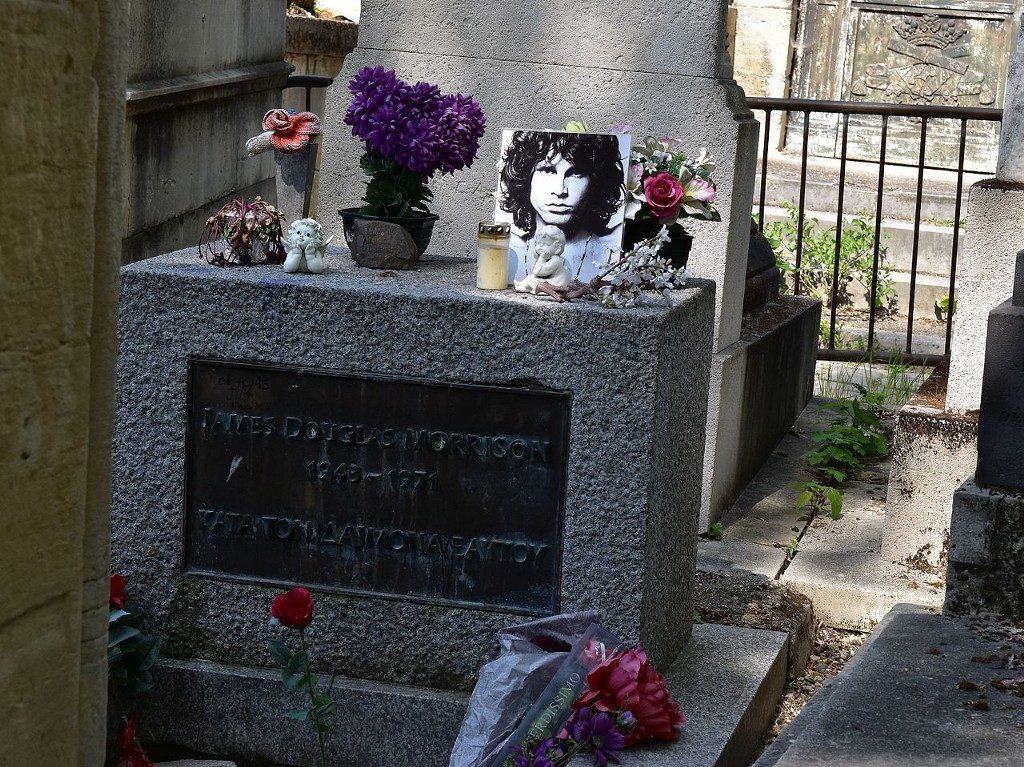
SALLY AND I WALKED out of the cemetery and wandered for an hour or so. Later in the overcast day, the temperature was dropping noticeably. Luckily, working our way back to the 4th Arrondissement, we came upon the Wild & the Moon, a part of this progressive, new-Paris movement of coffee shops.
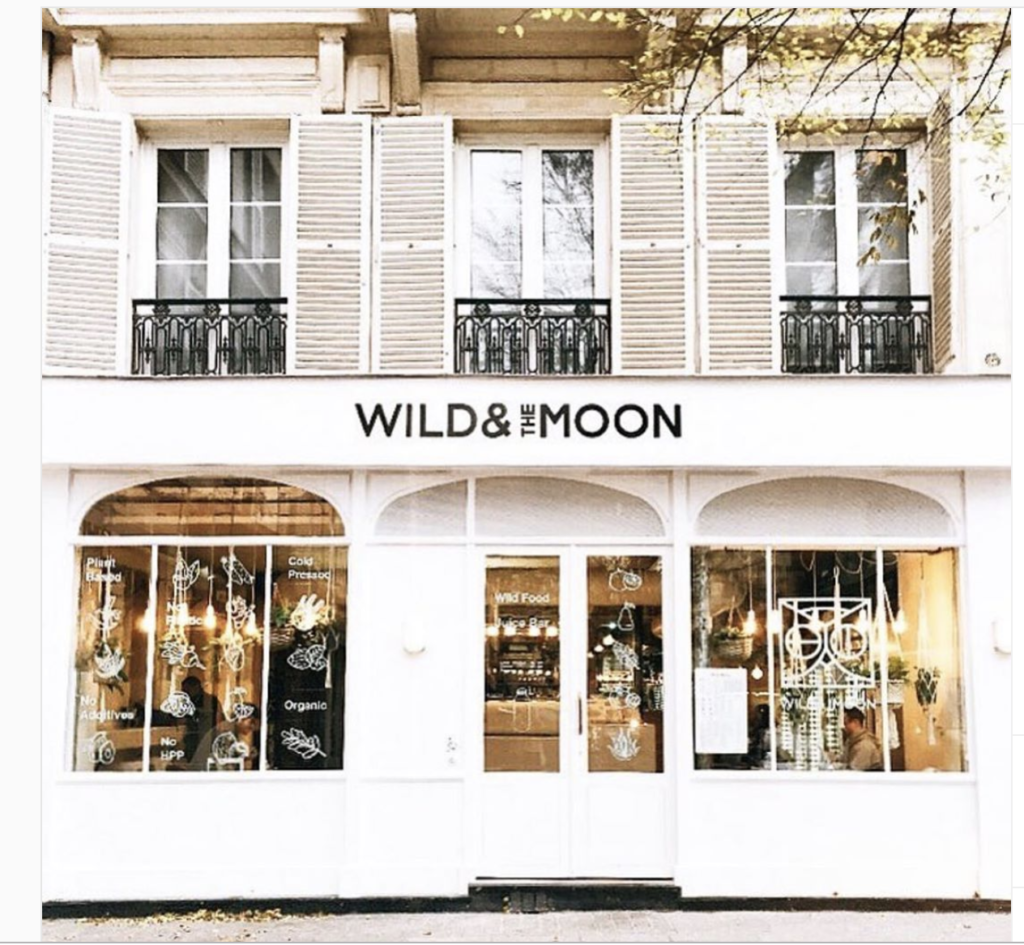
By its name and feel alone, you could tell it was going to be cozy and nurturing (and vegan). It had all of the telltale signs— white, bubbly, cursive writing on the windows, the phrase “Buddha bowl” somewhere on the menu. We got non-dairy lattes and warm, whole-grain bowls, which we clutched onto, filling ourselves with that wholesome, safe feeling of being huddled in a snug, homely place on the backend of a cooling, sun-setting fall day. We moved slow and spoke intently, softly smiling and content.
After W&M, we wandered into an adorable little paper products boutique called Papier Tigre where I bought a notebook. As I’ve spent my time more and more to writing over the past five years or so, there’s something about a paper goods and stationary store that I can’t get enough of. I could spend hours in one of those stores, and I don’t remember the last time I walked into one where I spent less than $30.
Notebook and Tigre stickers in hand, we continued back towards Le Marais and the Bastille (where Sally was staying) to quickly rest. The sky was electric ask dusk set in over the city.
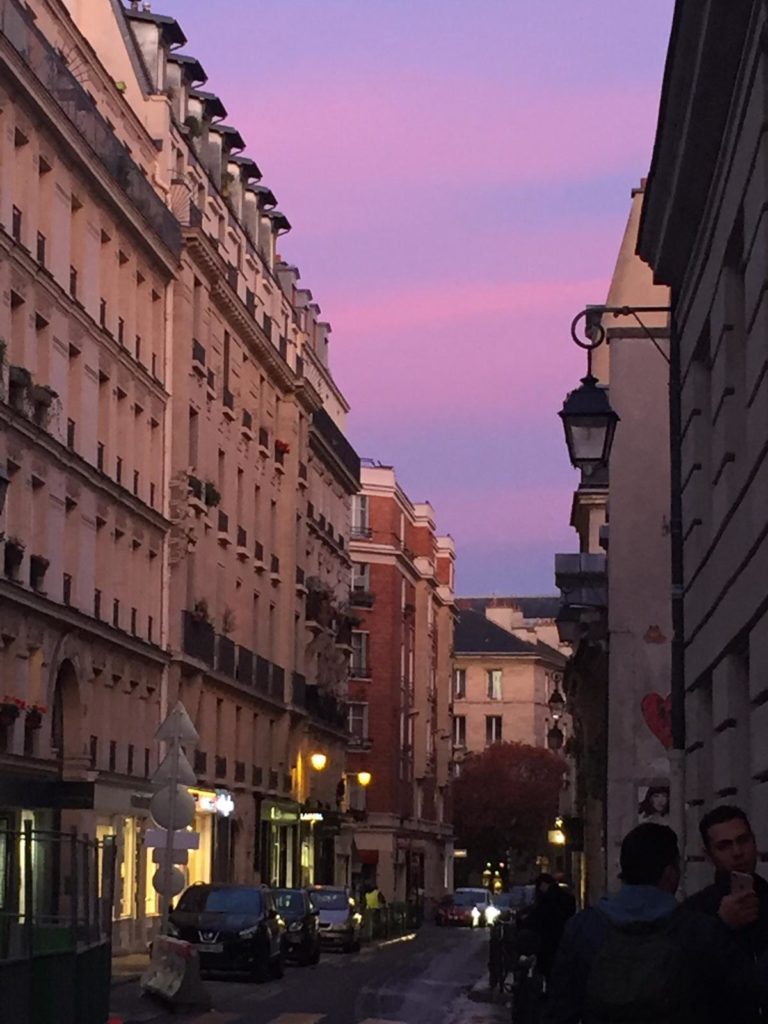
We got ready quickly and met for a pre-dinner beer. And after a hardy Moroccan dinner at Le 404, we headed back for an early bedtime. We wanted to be well-rested for our final day together at what is one of the best museums I’ve ever been to— the Orsay.
Musee d’Orsay
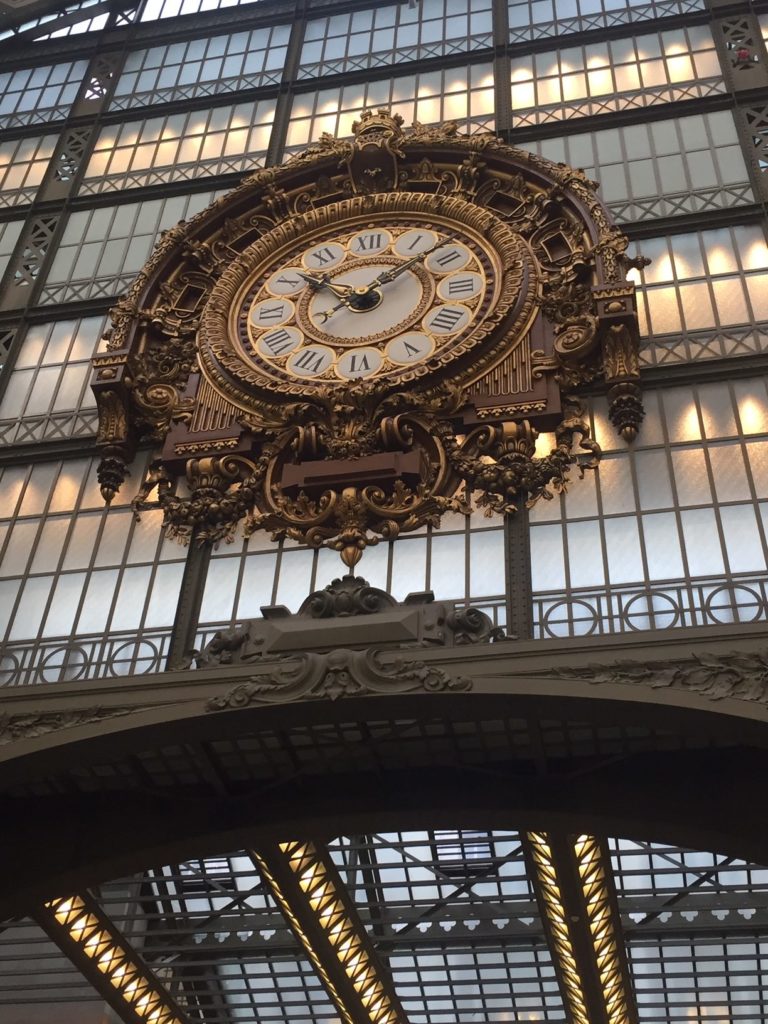
THE ORSAY MUSEUM IS LOCATED just across the river from the Louvre. From the outside, it appears ordinary as far as museums go— no glass pyramid or sprawling Frank Ghery job. There’s not a hint of the magnificence that lies inside. When Sally and I arrived, there was a lot of commotion outside, apparently some sort of delayed opening that morning. The line was already long, probably at least thirty minutes to get in, some said. Fortunate for us, we had an escort. I’d booked another Airbnb experience, this time with Carine, an official tour guide and art history scholar who had the credentials to leave these fidgeting, planless, line-waiters in our wake.
The first thing you notice about Carine is her smile. It’s the sort of smile that’s so big and permanent that it becomes hard to determine if it’s of the plastic sort of an experienced actor, or the sincere, squinted-eyed smile of a passionate teacher. We’d have to learn more before attempting to crack the code. With her credentials fashioned about her neck, Carine walked us right to the front of the line, and we entered the museum.
When we walked into the Orsay, I was struck by its resemblance to a place I knew quite well— Grand Central Station. Only, imagine you gutted Grand Central, touched up the walls, and installed multi-leveled, block-like viewing platforms of some of the most beautiful art that has ever been made.
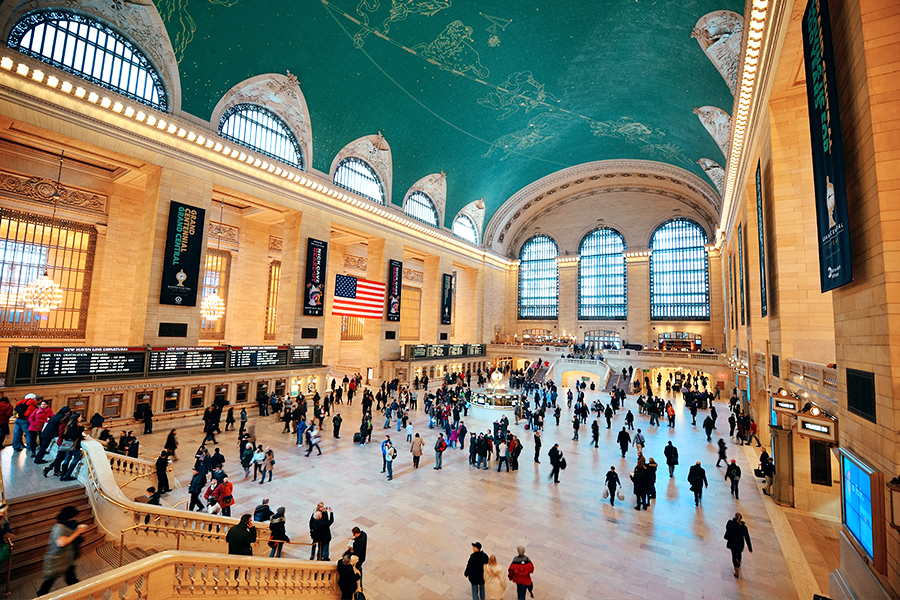
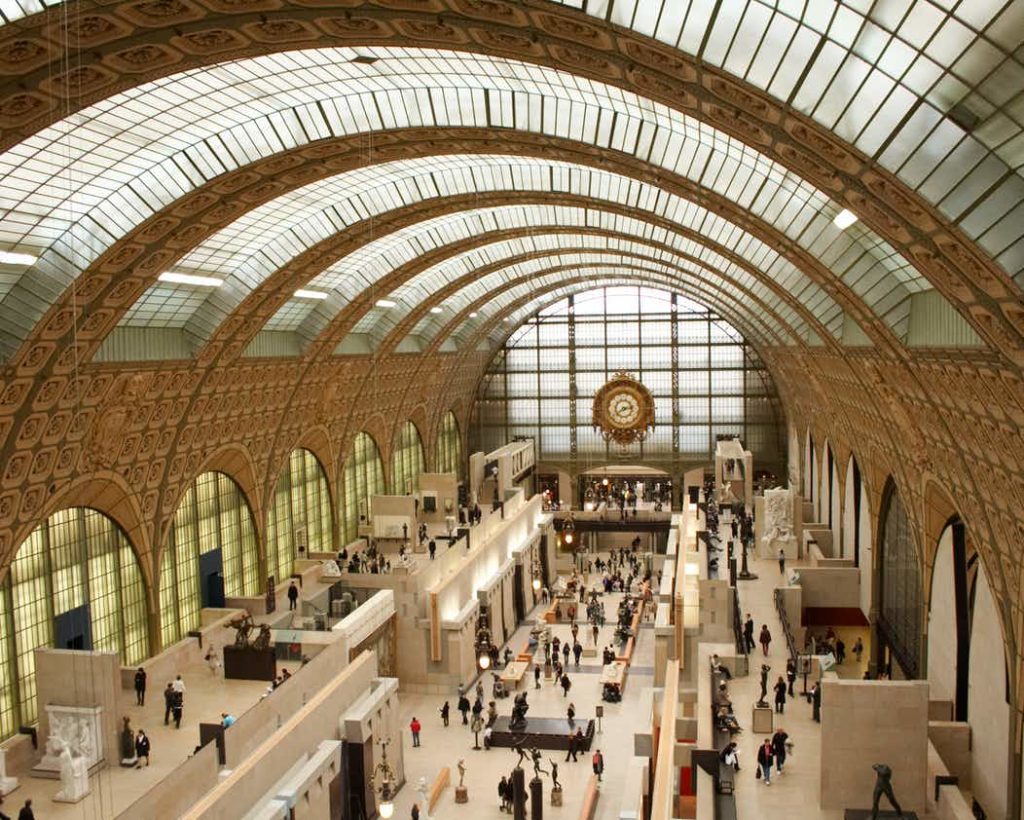
And in fact, it had been a railway station. The railway station, called the Gare d’Orsay, was built at the turn of the 20th century, creating the first urban, ‘electrified’ terminal station in the world. It was largely modeled off of the Baltimore Belt Line (Bmore shout out). Prior to being converted to a train staton, it had been, surprise— a palace—, and, like the Tulieries Palace, and, it seems, every pre-1870s palace in Paris, was burned by the Soldiers of the Paris Commune.
As we moved through the lobby and towards a small staircase which marks the tour start, we came across the symbol for the Paris ‘Coat of Arms,’ which I found unexpectedly moving. On it was the picture of a lone ship being tossed in waves on a background of red, sailing below the fleur-de-lis. At the bottom, the city motto was written in what looked to be Latin It said, ‘Fluctuat nec mergitur,’ which Carine translated for us: “[She] is tossed [by the waves], but does not sink.” I liked that.

Carine told us that she’d be focusing the tour on Impressionism, the area she’d studied just across the Seine at the Louvre. This made total sense, given that the Orsay has the single largest collection of Impressionist art in the world. And though I was slightly disappointed we wouldn’t be seeing the current Picasso exhibit—one focusing on his early ‘blue’ and ‘rose’ periods— I was also excited to hear an Impressionist scholar talk about what was becoming my favorite period of art history. And a bubbly scholar at that.
The first painting we looked at was one by Thomas Couture called Romans During the Decadence (1847). To me it looked sort of ordinary, not unlike a thousand paintings I’d seen before. It was just like a painting you’d see in the Louvre— a bunch of Greeks or Romans, eating some meal, flowy clothing hanging from their bodies, chalices in their hands. But Carine explained that this was very ‘avant garde,’ meaning it was new grounds for the time period. Apparently this was due to the revery they all seem to be in, half-naked and drinking heavily.
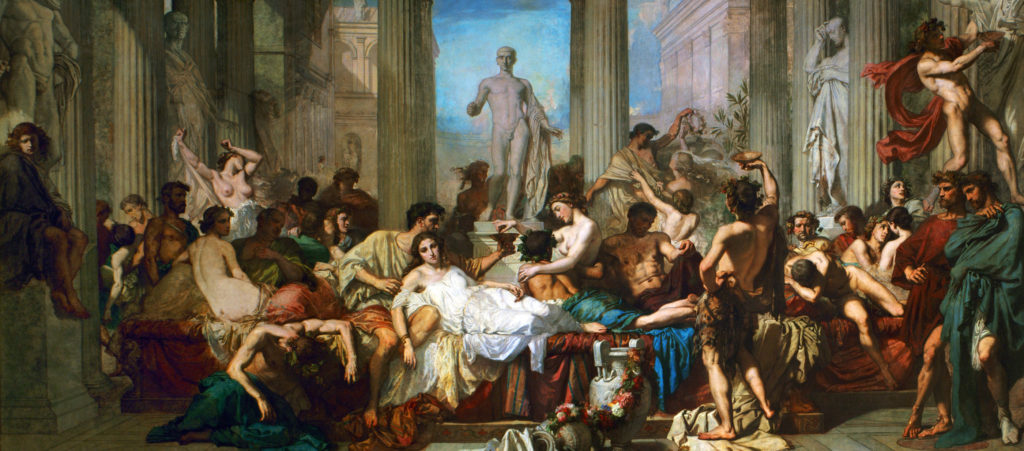
Often, I find it hard to appreciate things like that— things that were innovative and daring in their own time, but now seem ordinary. I guess everything seems ordinary after it’s been discovered and done.
[FYI, avant garde is a reference to those soldiers fighting ahead of the front line. It literally translating to “fore-guard’ or ‘in front of the guard.’ (You can stop pretending you know, now)].But Couture was no ordinary man. Though he won fame (and government commissions) due to the success of paintings like Romans, Couture would eventually go his own way, embodying the rebellious attitude of the forthcoming Impressionist movement.
In fact, he would soon teach many of the pioneer impressionists in his private atelier (workshop), including Edouard Manet, a man many credit with starting the Impressionist movement, and the one we’d start with after we ascended to the third floor.

The Impressionists
Carine’s excitement was palpable as we walked in front of the first Manet painting. She’s one of those people who never fully stops smiling, sometimes in that embarrassed sort of way that a teenager might display in front of an admirer, other times with the jumping, deliriously of the first day of a vacation. With such endearing excitement, she pointed to and described an apparently controversial Manet painting called Le Déjeuner sur l’herbe (The Luncheon on the Grass). We had no choice but to match her enthusiasm.
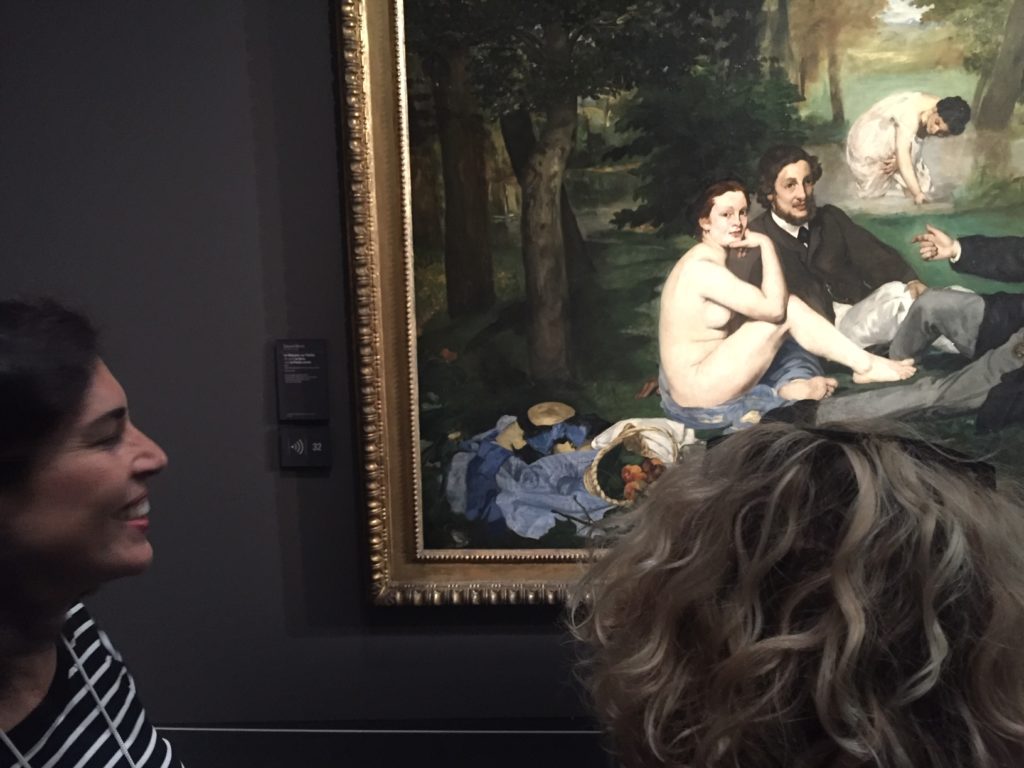
As we inspected the painting, Carine started to explain the story behind it. Le Dejeuner caused outrage when it was submitted for the Paris Salon of 1863. The evaluators of at the Paris Salon— the one’s who decide whether or not your painting was Salon-worthy (i.e. ‘real art’)— rejected it outright. But, as would eventually happen a decade later for the likes of Monet and Cezzane, the rejection ended up providing the grounds for a new salon in Paris, called, fittingly, the Salon de Refuses.
Apparently, Napoleon III, a lover of art and, evidently, the democracy of ideas, felt that the public, not the arrogant committee at the Paris Salon, should decide what is and is not ‘real art,’ so he commissioned a second salon.
Let’s hear it for those Napoleons, right? I mean, Bonaparte allowing for indiscriminate burial, and now his nephew, prior to his capture eventual exile following the Commune in 1870, was encouraging art equality. You know, besides that whole blood-thirsty, power-hungry stint— they seem like pretty swell little men.
As we moved through the museum, we would eventually see Cezanne’s Still Life With Apples, Van Gogh’s Bedroom in Arles and Gougin’s several Tahitian sculptures (which have their own, scandalous story. Carine hates him), but the MVP of the Impressionist movement was Claude Monet. And my favorite Monet, by far, was his Impression, Sunrise. It was, after all, the story that gave perhaps the most ardent push towards Impressionist fame.
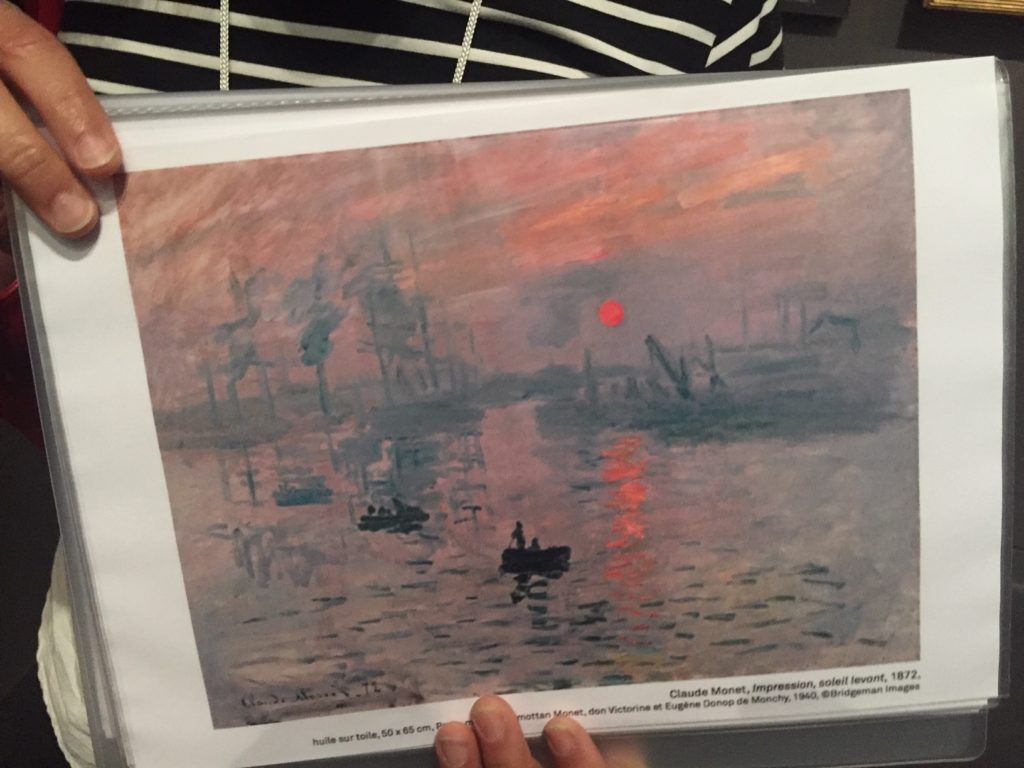
When Sunrise was first presented, it was laughed at. Rejected, of course, by the Paris Salon. And even though it was eventually placed in a secondary salon (eventually called the Salon of the Impressionists), it was heavily criticized. It was barely art, people said. While Manet’s early paintings were a sort of gaudy Realism— Realism being the accepted mode of the day— Monet was painting something far less identifiable. The brush strokes were short and spotty, creating pictures that looked almost blurred. The idea was to bring the focus less to the details of Realism, and more to the light and color of the moment—its spirit, perhaps.
But this was not yet appreciated, far from it. Famously, an article was written up by one critic, cutting to bits Monet’s work. The critic said that the work was barely painting at all. “Wallpaper in its embryonic state is more finished than that seascape.” Mocking the title he called it a mere impression of art, indeed. I guess he was right…
It was this that gave the impressionists their name, sparking their overarching attitude— one of rebellion. Taking on the name given by the critics is a move that screams counter-culture (See: Beatniks).The age-old but inspiring story of the misunderstood youth refusing to take shit from the misunderstanding incumbents. The old guard stubbornly ignoring Dylan’s advice to get out of the [way] if you can’t lend your hand.
***
AS THE TOUR WAS ROUNDING OUT, Sally and I having battered Carine with endless barrages of questions, we hardly wanted to leave. And there was one more surprise in store.
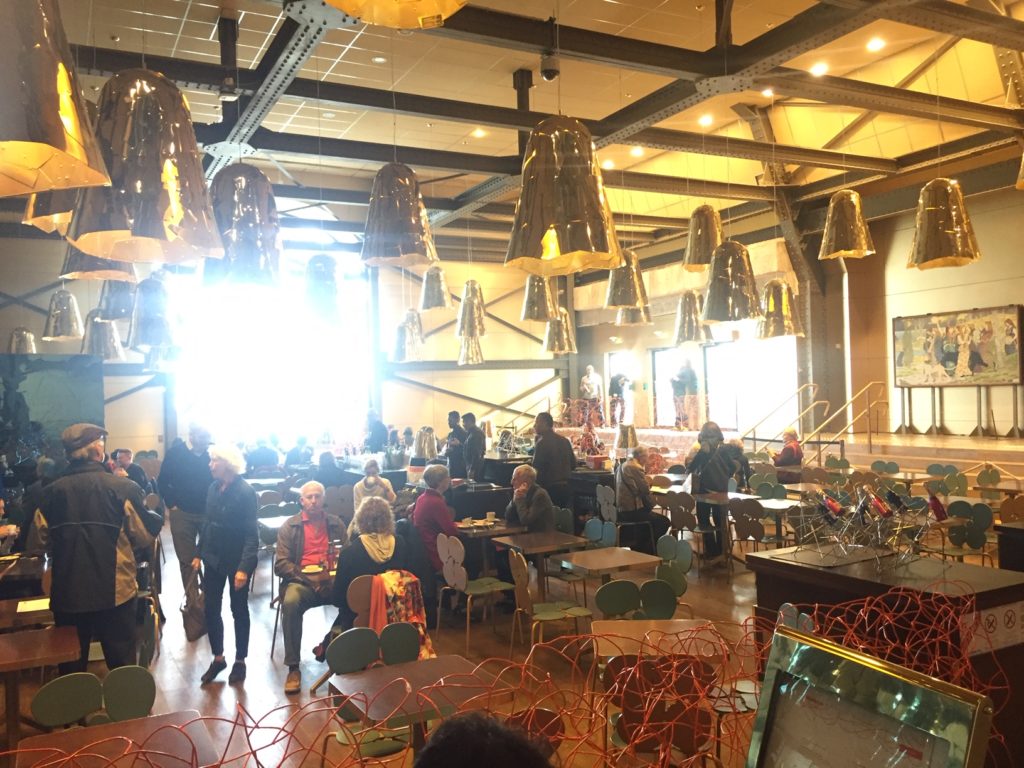
At the top of the Orsay is a Café Camapana. When you walk in, you’re captivated by the bold golds and reds, and stream of light shining through a translucent clock. The food in these places is never any good, but Sally and I agreed, this café is the type of place we’d pay the $42 euro for the average-tasting, undersized soup and salad, just to eat slow, and gaze upon the city through the concave impression of the clock.
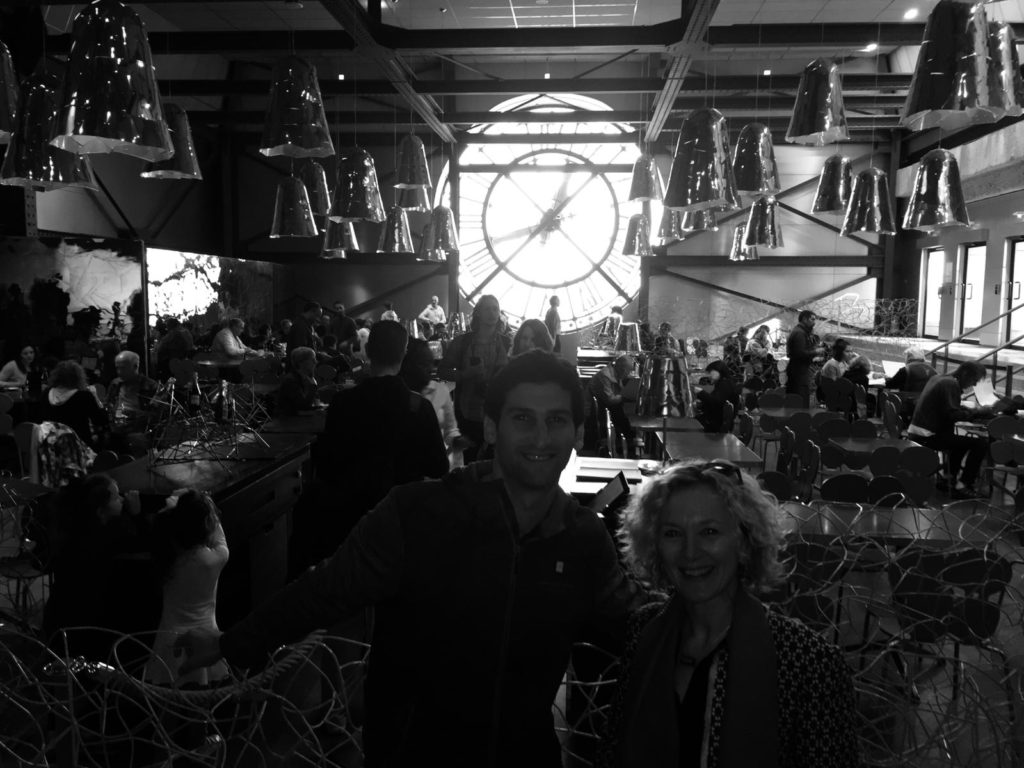
Sally and I contemplated canceling our fancy lunch, maybe inviting Carine to join us, but we decided against it, wanting more than anything to walk the city on this brilliant day. As a consolation prize, I got Carine’s email to potentially go on her other tour— a guided trip outside the city to Monet’s old home at Giverny. This was the spot he famously painted his ‘Water Lillies.’ The lilies, like almost everything by his brush, so ordinary, and yet, like some Dillard passage about Tinker Creek, illuminated something profound.
I later saw more Lillies in another museum across town days later called Musee Marmatton Monet. I highly recommend.

WITH JUST A FEW HOURS BEFORE SALLY’S flight was to take off, we said goodbye to Carine— a harder goodbye than either of us had imagined— and headed Northwest, along the left bank towards L’Ami Jean, a highly recommended restaurant. The sun was high in the sky, and its chilled beam on the brisk fall day coated us in color and filled us with energy, as we rambled on.
We arrived at L’Ami Jean just in time for our 12:30 PM reservation. White-table-clothed and wood furnishing, this was the type of place, we were told, to go for lunch if you wanted the ‘traditional french’ dining experience. It did not disappoint.

On the menu: Poullet. Another older friend and sort of mentor, Bob, a man well-respected among the famous New York restauranteurs among others, always told me that when he goes to a highly-rated restaurant, he always orders the chicken. I thought this counterintuitive. Why order something as plain as chicken? The key, Bob would tell me, is that chicken is so simple that barely anyone messes it up. But, only the few, really gifted chefs make it exceptional.
Luckily, the chicken was the main dish being offered on the lunch price fixe. Not as luckily, my Veganhood has given me some mental block about poultry. I could tell it was quality, but still did not find the eating experience that gratifying. I think Sally enjoyed it.
On the other hand, my veggie-life has done nothing to curb my sweet tooth. The desert was phenom—. Meringue (which I can usually take or leave), ice cream, some form of warm pastry, all in a bowl, dusted with powdered sugar. The wine was burgundy white, dry and lovely. The conversation was even lovelier.
We spoke about relationships, I being a long-time single. Why did we think that was? I mean, I’m a nice, open, intentional, curious person, right? So what was I missing? Luck? Timing? Something deeper?
The scary part of the whole thing was the prospect of it never turning around. I sat there, sipping my wine, brooding on that potential reality.
It brought to mind a pretty bleak but, I think instructive quote from Alexander Supertramp. One he wrote as he died from a poison plant in a broken-down bus in the middle of the Alaskan wilderness:
“Happiness is only real when shared.”
But, don’t worry, an active optimism and effort still has its hands on my beliefs with respect to love. I won’t stop trying anytime soon.
We paid the check and walked on the Seine a bit before catching a cab. Time was running short.
***
IN THE CAB TO SALLY’S HOTEL, she told me a story. The subject of love and relationships at lunch had reminded her of a video she’d seen that made her cry.
It’s about a women and a man who fell in love. She was 45, he was 29. They met in France and the woman tells of the sensuality, the immediate captivation they both felt almost at sight. They made love all over town. They couldn’t keep their hands off each other.
The young man was a painter, a sculptor, a musician, sensitive, passionate, patient, playful. And perhaps his most glowing trait, he absolutely beamed over kids.
But then a realization came over the 45 year old woman one day that froze her heart. Having already had kids who were now grown, she did not want any more. She asked him, knowing the answer, ‘do you want kids?’ And when he replied ‘of course,’ she knew she’d have to leave him.
It took almost four years for them to finally separate. He didn’t want to split up, he tried to convince her it would work, but the wiser woman knew this would have to end. So over those last four years, she searched for a women for him. She knew it would take another princess to break the spell. And though it would crush her, that’s how much she cared for the young man.
And then, one day, she walked by.
She had blazing, red hair covered with a plush fedora. Her ora made the older woman vibrate. It was the most magnificent woman she’d ever seen. So she walked up to her, befriended her, and a month later, introduced her to ‘my friend’— the young man. When they met, the older woman could tell, this was it.
She cut off contact, changed her phone. She stayed away for four years without contacting either of them. And then, one day, four years later, she decided to go see him.
And when she arrived, this little tiny girl with red hair starting running up to the older woman as if she’d known her all her life. The little girl said: “c’est toi la fee?”
‘Are you the fairy?’
***
WE BOTH GOT OUT AT SALLY’S HOTEL. Just 10-15 minutes before she was off to the airport, I would wait in the lobby for her, send her off, and walk the 10 minutes or so back to Le Marais.
It had been a quick trip, but impactful. And as it is every time, a little bittersweet when she got down to the lobby. We hugged— a real hug— and said we’d be seeing each other soon, somewhere…
I helped her with her bags, shut the cab door, and waved to the rear windshield.
***
THAT EVENING, I WAS MEANT TO go to L’arpege, a bougie, Michelin-type, vegetarian restaurant, but then realized it was going to be about $400 euros and quickly decided it was not worth it. Instead, it went to the falafel place that your boy, Lenny Kravitz, made famous and every Jew will recommend to you called L’As du Falafel. Its fine— very good for falafel, but I feel there is an inherent limit in anything deep-fried, especially chickpeas. I bought some figs on my way home to complete the middle eastern cuisine.
Then, only 8pm, it was time to go home. I wanted to go to sleep early as I had to be over at the Louvre at 9am and I hadn’t slept very much in the last few days. I got back to my cozy little flat, uncoiled the sofa-bed, and took a hot shower— a much slower one, this time.
Then I got into bed, turned the light off, and watched a documentary about Camus.
[1] ‘Guys’ in the plural, mixed-sex version, as in the Spanish ellos. I recognize it’s sexist / gender-fensive, but hey, I didn’t make the rules here, guys.
[2] All English people end their sentences with that confirmatory, ‘isn’t it’ or ‘wasn’t she?’ Not so much a question as an implicit pressure to agree with the statement they just made. I find it hilarious.
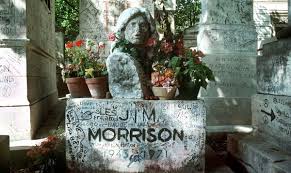


2 Comments on “Scenes from Paris IV: Jim Morrison’s Grave, the Orsay, and my British Guest”
This was your best and I have loved all the articles.
Thanks, Grams! I appreciate you reading and all the feedback. Glad to hear you enjoyed.